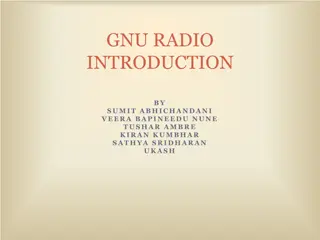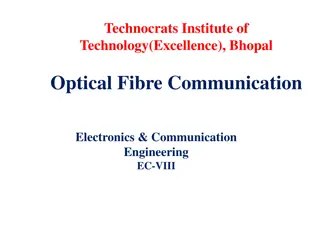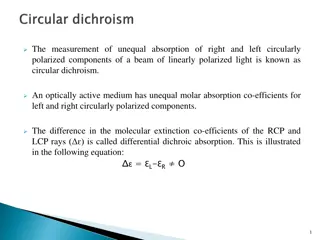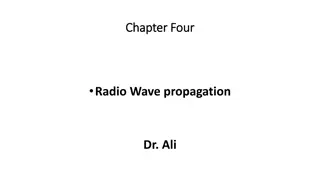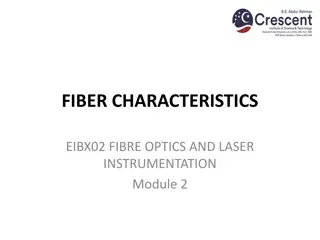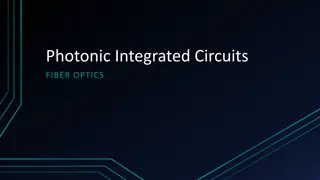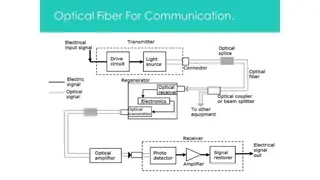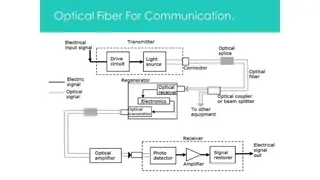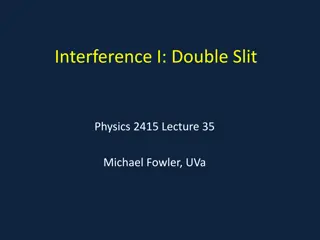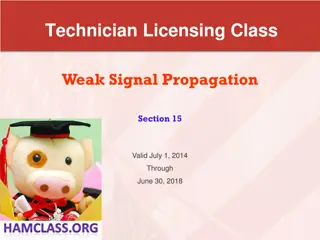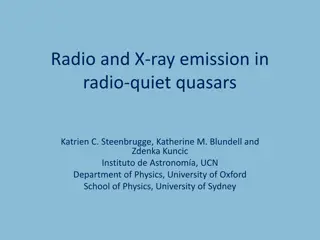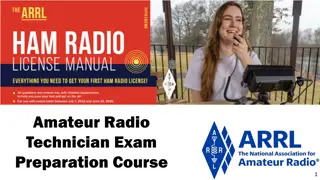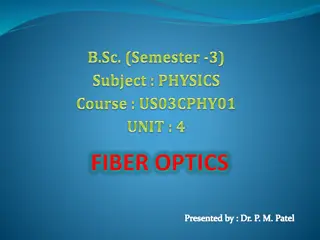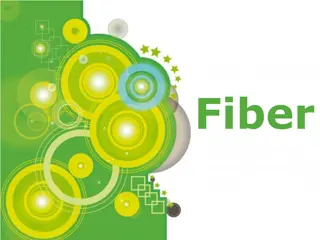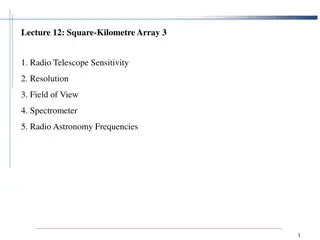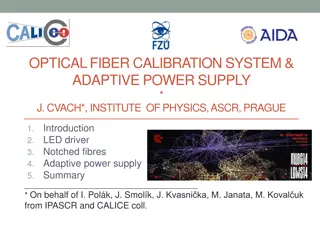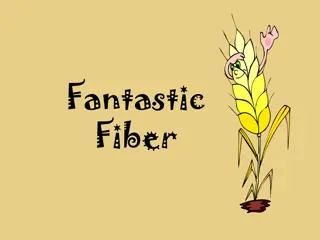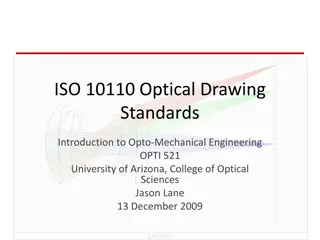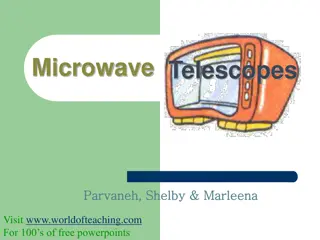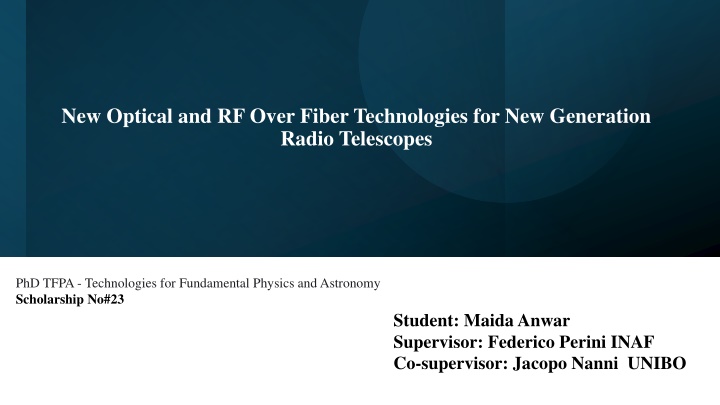
New Optical and RF Over Fiber Technologies for Radio Telescopes
Scholarship recipient Maida Anwar embarks on a research journey focused on optical and RF over fiber technologies for next-gen radio telescopes. Starting in Italy, the timeline outlines her academic pursuits, including attending courses, conducting literature reviews, and participating in conferences and seminars. With a strong foundation in fundamental physics and astronomy, Maida's work promises innovative advancements in the field.
Download Presentation

Please find below an Image/Link to download the presentation.
The content on the website is provided AS IS for your information and personal use only. It may not be sold, licensed, or shared on other websites without obtaining consent from the author. If you encounter any issues during the download, it is possible that the publisher has removed the file from their server.
You are allowed to download the files provided on this website for personal or commercial use, subject to the condition that they are used lawfully. All files are the property of their respective owners.
The content on the website is provided AS IS for your information and personal use only. It may not be sold, licensed, or shared on other websites without obtaining consent from the author.
E N D
Presentation Transcript
New Optical and RF Over Fiber Technologies for New Generation Radio Telescopes PhD TFPA - Technologies for Fundamental Physics and Astronomy Scholarship No#23 Student: Maida Anwar Supervisor: Federico Perini INAF Co-supervisor: Jacopo Nanni UNIBO
Timeline of 1st year Initial Phase (Nov 2023 - May 2024) Due to visa issues, arriving in Italy late in May 2024 Feb-April: Taking online classes from Pakistan for Optical Fiber System M Weekly meeting with supervisors Post Arrival (May 2024 - Present) Attending course " Optical Fiber System M" in person Following the "Radio and Optical Interferometry" course Conducting a literature review Defining the state of the art for the research topic Conferences, Seminars, School Kick off meeting 10-11 July 2024 Padua, Italy Conference MWP2024 International Topical Meeting on Microwave Photonics 17-20 September Pisa, Italy
Timeline of 1st year Initial Phase (Nov 2023 - May 2024) Due to visa issues, arriving in Italy late in May 2024 Feb-April: Taking online classes from Pakistan for " Optical Fiber System M Weekly meeting with supervisors Post Arrival (May 2024 - Present) May-June: Attending course "Optical Fiber System M" in person, Cr 7.5, Exam Passed on Early July May-June: Attending the course "Radio and Optical Interferometry" held remotely, Cr 1.5, Exam scheduled early Oct Conducting a literature review and state of art for research topic Read Books about fundamentals ofRoF technologies, RF measurements, Radio Astronomy Conferences, Seminars, School Kick off meeting 10-11 July 2024 Padua, Italy Conference MWP2024 International Topical Meeting on Microwave Photonics 17-20 September Pisa, Italy
Timeline of 1st year Initial Phase (Nov 2023 - May 2024) Due to visa issues, arriving in Italy late in May 2024 Taking online classes from Pakistan for " Optical Fiber System M Weekly meeting with supervisors Post Arrival (May 2024 - Present) May-June: Attending course " Optical Fiber System M" in person, Cr 7.5, Exam Passed on Early July May-June: Attending the course "Radio and Optical Interferometry" held remotely, Cr 1.5, Exam scheduled early Oct Conducting a literature review and state of art for research topic Read Books about fundamentals ofRoF technologies, RF measurements, Radio Astronomy Conferences, Seminars, School Kick off meeting 10-11 July 2024 Padua, Italy Conference MWP2024 International Topical Meeting on Microwave Photonics 17-20 September Pisa, Italy on Microwave Photonics 17-20 September Pisa, Italy
Research Topic and Objectives Design and Realization of wide band (1-18GHz) radio over fiber systems for the IF downlinks of INAF VLBI antennas (Medicina and Noto) Starting point: The current optical link purchased for SRT (Sardinia Radio Telescope) Direction of research: Improvement of the dynamic range from architectural and component perspective ORX OTX RoF block diagram
Current RF-over-Fiber link for SRT Mach-Zehnder Modulator 1-18GHz OTX Input signal Optical Source(Laser) Low Noise Amplifier Photodetector Amplifier 1-18GHz ORX Output RF signal
Requirements of current optical link purchased for SRT Parameter Value Unit Frequency band Gain(mean value in band) Gain Smoothness Input Return Loss Output Return Loss Input P1dB* Input IP3 Input IP2 NF Cost 1-18 14 2.5 GHz dB dB dB dB dBm dBm dBm dB K 1 (on 2GHz bandwidth) >10 >10 >-11 (-6) >-11 >-11 <6 <17.5 -6 dBm was the original specification which has been relaxed to -11dBm because the spec was not reachable with COST system*
Possible Improvement of the dynamic range from architectural perspective Transmission Side Cascaded MZIs with series Mach-Zehnder modulators to handle both second- and third-order distortions and for improved linearity. Parallel MZIs to handle both second- and third- order distortions. Modified directional couplers designed to reduce Chromatic dispersion. (a) series MZIs (b) parallel MZIs (c) modified directional coupler modulator
Possible Improvement of the dynamic range from architectural perspective Transmission Side Cascaded MZIs with series Mach-Zehnder modulators to handle both second- and third-order distortions and improved linearity. (a) series MZIs (b) parallel MZIs (c) modified directional coupler modulator Parallel MZIs to handle both second- and third-order distortions & improved linearity. Modified directional couplers designed to reduce Chromatic dispersion.
Possible Improvement of the dynamic range from architectural perspective Transmission Side Cascaded MZIs with series Mach-Zehnder modulators for second- and third-order distortions and improved linearity. Parallel MZIs to handle both second- and third- order distortions and improved linearity. Modified directional couplers designed to reduce Chromatic dispersion. (a) series MZIs (b) parallel MZIs (c) modified directional coupler modulator
Possible Improvement of the dynamic range from architectural perspective (a) Receiver Side a) Velocity Matched Distributed Photodetectors (VMDP) provide high-speed performance with independent optimization of optical waveguide, photodiode, and microwave transmission line. Enhance bandwidth and suppressing common mode noise through balanced mode operation. b) Parallel Optical Feed Photodetectors achieve uniform photocurrent by splitting optical power among multiple diodes using multimode interference (MMI) splitters. higher saturation current can be achieved c) Integrated impedance matching networks to minimize signal reflections Backward Wave Cancellation (BWC) in multisection lines to eliminate backward waves, reduce destructive interference, and improve bandwidth.
Possible Improvement of the dynamic range from architectural perspective (a) Receiver Side a) Velocity Matched Distributed Photodetectors (VMDP) provide high-speed performance with independent optimization of optical waveguide, photodiode, and microwave transmission line. Enhancing bandwidth and suppressing common mode noise through balanced mode operation. (b) b) Parallel Optical Feed Photodetectors achieve uniform photocurrent by splitting optical power among multiple diodes using multimode interference (MMI) splitters. Higher saturation current can be achieved c) Integrated impedance matching networks to minimize signal reflections Backward Wave Cancellation (BWC) in multisection lines to eliminate backward waves, reduce destructive interference, and improve bandwidth.
Possible Improvement of the dynamic range from architectural perspective (a) Receiver Side a) Velocity Matched Distributed Photodetectors (VMDP) provide high-speed performance with independent optimization of optical waveguide, photodiode, and microwave transmission line. enhancing bandwidth and suppressing common mode noise through balanced mode operation. (b) b) Parallel Optical Feed Photodetectors achieve uniform photocurrent by splitting optical power among multiple diodes using multimode interference (MMI) splitters. higher saturation current can be achieved (C) c) Integrated impedance matching networks to minimize signal reflections Backward Wave Cancellation (BWC) in multisection lines to eliminate backward waves, reduce destructive interference, and improve bandwidth.
Opto-electronic Components Mach-Zehnder Modulator Critical component Photodetector Critical Component Laser Slightly less critical compared to others
Opto-electronic Components Mach-Zehnder Modulator Critical component Photodetector Critical Component Laser Slightly less critical compared to others
Mach Zehnder Modulator Characteristics to be focused Insertion loss (IL) absorptive loss of optical waveguides Fiber-coupling loss Linearity-Gain/Noise trade-off Optimization of ?? Bandwidth strength of the electro-optic effect in the material stability of the material Cost of manufacture Layout of Mach Zehnder modulator* *Singh, R., Ahlawat, M., & Sharma, D. (2017). A review on radio over fiber communication system. International Journal of Enhanced Research in Management & Computer Applications, 6(4), 23-29.
Photodetector High Bandwidth (20GHz) Higher electron mobility High Linearity thermal management to reduce temperature-induced nonlinearity. Employ materials with minimal nonlinear optical properties High Power received High saturation current photodetectors Enlarge absorption volume to reduce space charge effects and thermal runaway under high- power illumination High Responsivity conversion of optical power into electrical signal
Future Plan 2nd Year Full and deep measurement characterization of the SRT RoF links both in the lab and on the antenna Check and refresh the RF specifications after new receiver installation on SRT and Medicina/Noto Simulation of new architecture using MATLAB and AWR software Components analysis COMSOL Multiphysics Follow course Laboratory of Microwave Photonic T (Sep-Dec 2024) Follow course High Frequency Electronic Circuits M (Sep-Dec 2024) Follow course Fundamental system engineering and project management for large scientific projects
Future Plan 2nd Year Full and deep measurement characterization of the SRT RoF links both in the lab and on the antenna Check and refresh the RF specifications after new receiver installation on SRT and Medicina/Noto Simulation of new architecture using MATLAB and AWR software Components analysis COMSOL Multiphysics Follow course Laboratory of Microwave Photonic T (Sep-Dec 2024) Follow course High Frequency Electronic Circuits M (Sep-Dec 2024) Follow course Fundamental system engineering and project management for large scientific projects 3rd Year Validate New Architecture/Components through Lab and possibly Field Testing Thesis Writing
Questions Questions

